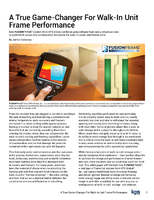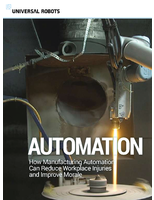Oscilloscopes integrate PCI Express decode annotation.
Press Release Summary:
LeCroy oscilloscopes feature PCI Express 1.x, 2.0, and 3.0 decode annotation, which provides link layer protocol decode for up to 4 PCI Express signals annotated on oscilloscope physical layer waveform. Various oscilloscope analysis tools may be used concurrently. Initial data rate for decoding may be set to 2.5, 5, or 8 GT/sec, while protocol message types are color-coded for visibility. Decoded information is tabulated and data can be exported in Excel format for offline analysis.
Original Press Release:
LeCroy Introduces PCI Express Gen 1.x, 2.0 and 3.0 Decode Annotation on Oscilloscopes to Speed Validation and Debug
Add PCI Express Protocol Awareness to Oscilloscope Physical Layer Tools
CHESTNUT RIDGE, N.Y., Nov. 3 / / - LeCroy Corporation's PCI Express Decode Annotation for LeCroy oscilloscopes provides new capability for hardware and system engineers to simultaneously understand the physical layer and protocol behavior of high-speed PCI Express serial data signals. The new capability provides a link layer protocol decode for up to four PCI Express signals annotated on the oscilloscope physical layer waveform. It is the first and only oscilloscope-based decode solution for the widely adopted PCI Express Gen 2.0 and the emerging PCI Express Gen 3.0 standards. Combined with LeCroy's 8b/10b decode annotation tool (a separate option), simultaneous symbol/primitive and protocol level understanding can be achieved. For faster time to insight, all the standard math, measure, cursor, zoom, and other analysis tools available in the oscilloscope may be used concurrently.
The new PCI Express Decode Annotation capability has widespread application for all versions of PCI Express. It is especially helpful for the emerging PCI Express Gen 3.0 standard, where new silicon physical layer (PHY) links are beginning to be validated before the standard has been finalized. In the early PHY validation stages, the physical layer signals may not exhibit the desired signal fidelity, and a significant amount of physical layer debug must often occur before a specialized protocol analyzer can be used. In addition, it can be difficult to time correlate protocol analyzer and oscilloscope captures; therefore, interpretation of the information from the two different tools could be more time consuming and more error prone. By providing the decoded information as an annotation on the physical layer waveform within the oscilloscope, the protocol and physical layer information is synchronized, and permits easy scrolling and review of the captured data, as is often necessary. Thus, interpretation is easier, faster, and more reliable in the early PHY validation stage.
PCI Express Gen 1.x, Gen 2.0 present their own challenges. Interoperability issues detected at a compliance workshop may be difficult to debug independently with either a protocol analyzer or physical layer compliance test because the problem is often due to correlated physical layer/protocol transmission problems. By showing the link layer protocol decode and the physical layer waveform simultaneously on the oscilloscope, debug time can be dramatically decreased. PCI Express Gen 1.x, widely available in embedded microcontrollers, is used by a wide pool of hardware and systems engineers who may not be familiar with PCI Express. By providing a link layer decode annotation on the oscilloscope, it becomes easier for these engineers to implement this standard in their design, and also assess the relationship between the PCI Express traffic and control lines or other signals in their embedded control system.
The initial data rate for decoding may be set to the common 2.5, 5, or 8 GT/s, PCI Express Gen 2.0 and Gen 3.0 begin handshaking at lower bit rates, and once the link is established, increase to their maximum data rate. The decode algorithm recognizes the different bit rates and decodes appropriately, and supports modes with and without scrambling enabled.
Intuitive, Color-Coded Decode Annotation
Advanced algorithms deconstruct the waveform into protocol information, and then annotate the physical layer waveform on the oscilloscope grid. Decode annotation condenses or expands depending on the timebase/zoom ratio setting. Various portions of the protocol are color-coded for intuitive, quick visual understanding of the protocol behavior and easy visibility, even with long acquisitions. For instance, TS1 and SKIPs are color-coded a grayish blue while Electrical Idle, Error, or Unrecognized frames are color-coded red. Other message types are uniquely color-coded.
Convenient Table Display and Search
Decoded information is conveniently shown in a tabular format. Simply touching a specific frame index in the table or searching for a specific frame type automatically creates a zoom trace showing physical layer detail along with expanded decode information. Search supports Compliance, EIEOS, EIOS, Electrical Idle/Error, DLLP, Logical Idle, SKIP, TLP, TS1, TS2, Unrecognized, or Any Type of frame. Engineers may easily display all TS1 frames by searching for the first and then simply pressing "Next" to advance through successive frames. Off-line data analysis is made simple by exporting tabular data in .csv format and analyzing the data later in Excel.
Support on Multiple Oscilloscope Platforms
The option is available on a wide range of oscilloscope models with real-time bandwidths from 2.5 GHz to 30 GHz (the world's fastest real-time oscilloscope) supporting the full range of PCIe users, from Gen 1.x to 3.0. To support the large installed base of LeCroy users, the option is fully compatible with the WavePro 7 Zi, WaveMaster 8 Zi, WavePro 7000, and WaveMaster 8000 Series of oscilloscopes and serial data/disk drive analyzers based on these platforms (including SDA11000, SDA13000, and SDA18000). Bandwidth is recommended as >= the PCI Express GT/s rate, with a minimum oscilloscope sample rate requirement of 4x the data rate.
Further Information
Engineers and technicians who would like to learn more can contact LeCroy at 1-800-5LeCroy (1-800-553-2769) or visit the LeCroy web site (www.lecroy.com).
About LeCroy
LeCroy Corporation is a worldwide leader in serial data test solutions, creating advanced instruments that drive product innovation by quickly measuring, analyzing, and verifying complex electronic signals. The Company offers high-performance oscilloscopes, serial data analyzers, and global communications protocol test solutions used by design engineers in the computer and semiconductor, data storage device, automotive and industrial, and military and aerospace markets. LeCroy's 45-year heritage of technical innovation is the foundation for its recognized leadership in "WaveShape Analysis" - capturing, viewing, and measuring the high-speed signals that drive today's information and communications technologies. LeCroy is headquartered in Chestnut Ridge, New York. Company information is available at http://www.lecroy.com/.
Specifications are subject to change without notice.




